A butterfly flitting about in a meadow or forest is a sure sign of summer in Central Oregon. The longer, warmer days bring these colorful creatures out in the meadows of Camp Polk Meadow Preserve, the woodlands of the Metolius Preserve, and the juniper covered slopes of Whychus Canyon Preserve. Here are a few to watch for this summer: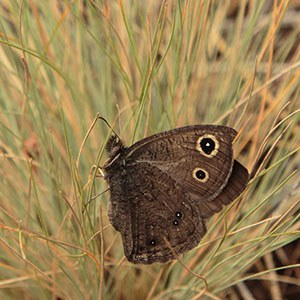 Dark wood nymph, Cercyonis oetus: This smaller species (<1.75”) displays yellow-ringed eyespots on it’s wing, a bright contrast to its often blackish or dark brown color. Look for this species in July in the grasses. It is a common sight in sagebrush meadows, east-side canyons, and mountain meadows and marshes. They enjoy the nectar of mock orange, mint, alfalfa, rabbitbrush, yarrow, buckwheat and others.
Dark wood nymph, Cercyonis oetus: This smaller species (<1.75”) displays yellow-ringed eyespots on it’s wing, a bright contrast to its often blackish or dark brown color. Look for this species in July in the grasses. It is a common sight in sagebrush meadows, east-side canyons, and mountain meadows and marshes. They enjoy the nectar of mock orange, mint, alfalfa, rabbitbrush, yarrow, buckwheat and others.
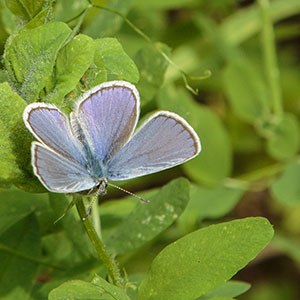 Anna’s blue, Lycaeides anna ricei (<1.25”): There are numerous different species of little blue butterflies (often referred to simply as “blues”) flitting about our Preserves in the spring and summer. To tell them apart, catch a glimpse of the undersides of their wings. Females display brownish-copper backs, while males are defined by their cool, grainy blue color. “Blues” often gather on damp soil (a behavior called “puddling”) to sip on salts and minerals.
Anna’s blue, Lycaeides anna ricei (<1.25”): There are numerous different species of little blue butterflies (often referred to simply as “blues”) flitting about our Preserves in the spring and summer. To tell them apart, catch a glimpse of the undersides of their wings. Females display brownish-copper backs, while males are defined by their cool, grainy blue color. “Blues” often gather on damp soil (a behavior called “puddling”) to sip on salts and minerals.
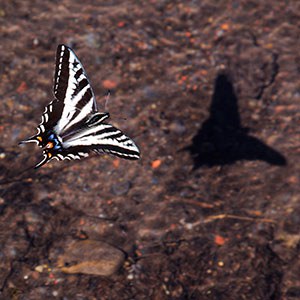 Pale tiger swallowtail, Papilio eurymedon: Look for this larger (>3”) butterfly starting mid-April in open woodlands like the Metolius Preserve. Their large black and white stripes and tail spots of reddish-orange can help you identify them. Adults nectar on penstemon, phlox, chokecherry and others, and can often be see in open areas as well as along streams and in canyons.
Pale tiger swallowtail, Papilio eurymedon: Look for this larger (>3”) butterfly starting mid-April in open woodlands like the Metolius Preserve. Their large black and white stripes and tail spots of reddish-orange can help you identify them. Adults nectar on penstemon, phlox, chokecherry and others, and can often be see in open areas as well as along streams and in canyons.
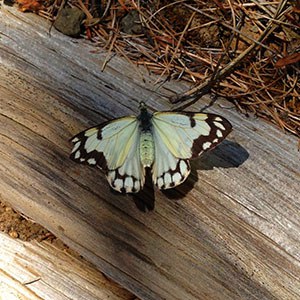 Pine white, Neophasia menapia: A rather elusive and small (<2”) butterfly, the pine white loves middle elevation forests. In the late summer months, look for these milky white insects in the morning or evening, drinking the nectar of yarrow, pearly everlasting, daisies and thistles. Mid-day, they’re often seen flitting about in the treetops, where they lay their eggs on pine and fir needles so their caterpillar offspring can feed on fresh spring growth.
Pine white, Neophasia menapia: A rather elusive and small (<2”) butterfly, the pine white loves middle elevation forests. In the late summer months, look for these milky white insects in the morning or evening, drinking the nectar of yarrow, pearly everlasting, daisies and thistles. Mid-day, they’re often seen flitting about in the treetops, where they lay their eggs on pine and fir needles so their caterpillar offspring can feed on fresh spring growth.
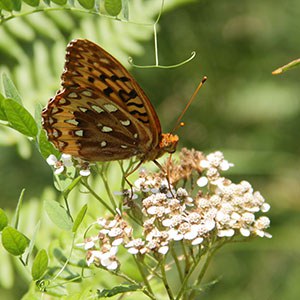 Great spangled fritillary, Speyeria cybele (<3”): Though not as common at Land Trust Preserves, this fritillary is the largest of the species and most distinctive. It’s always exciting to catch a glimpse of one soaring along the creek or cruising the forest margins and meadows in July. With most fritillaries, it’s difficult to distinguish between males and females, but the “great spangleds” make it easy, with males in our region displaying a fiery orange back and females a lovely dark chocolate.
Great spangled fritillary, Speyeria cybele (<3”): Though not as common at Land Trust Preserves, this fritillary is the largest of the species and most distinctive. It’s always exciting to catch a glimpse of one soaring along the creek or cruising the forest margins and meadows in July. With most fritillaries, it’s difficult to distinguish between males and females, but the “great spangleds” make it easy, with males in our region displaying a fiery orange back and females a lovely dark chocolate.
You can find these and other butterflies at your Land Trust Preserves! Want to learn more? Join us for a guided butterfly walk!


